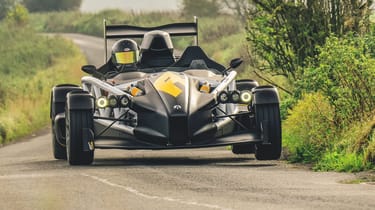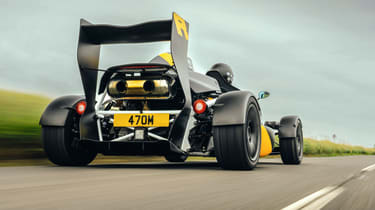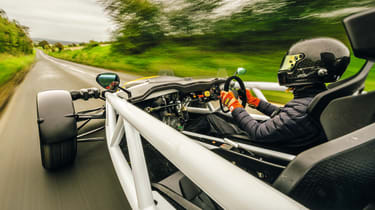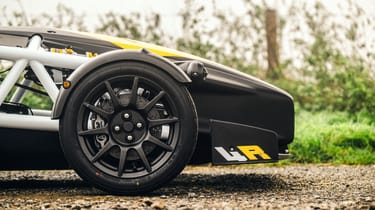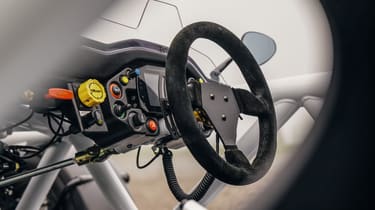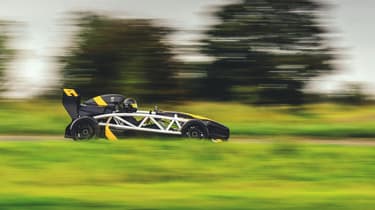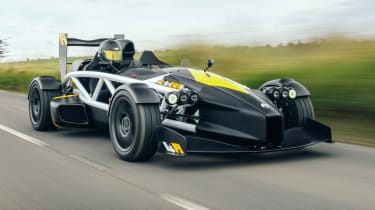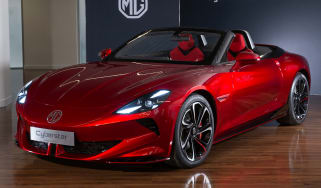Ariel Atom 4R 2024 review – skeletal track special is more intense than ever
The new R-spec Atom 4 adds muscle to the skeletal sports car. Does the sub-700kg Ariel really need another 80bhp? There’s only one way to find out
Who knew all that was going on behind the dashboard in the Honda Civic Type R? All that energy, that sound, that violence… The 2-litre four-cylinder turbo engine behind my shoulders is emitting all kinds of whoops and squawks, trills and flutters, like an entire aviary’s been ingested through the airbox. Actually, given the rate it’s propelling the Atom down the road, and the intense whooshing sound it makes as the turbo spools up, I wonder if Ariel might actually have swapped it for a jet engine.
In the already-rapid Honda hot hatch it’s sourced from, the 2-litre four turns out 324bhp. Installed in the regular Ariel Atom 4 (it seems wrong to use the word ‘regular’ for such a gloriously irregular car), which replaced the Atom 3.5 in 2020, it’s rated at 320bhp. The Atom 4R has 400bhp. As tested, it weighs 665kg.
> BAC Mono R 2023 review – the fastest car we've track-tested?
Without the extra weight of a large hatchback’s shell, seats and so on for the engine to carry – and the windscreen and firewall to contain its library of sound effects – and with an 80bhp shot in the arm, it comes as no surprise that the Atom 4R is Quite Brisk. But what’s about to become clear, as we get to know it properly over a mix of roads in remote, rolling countryside, is that interstellar-level straight-line urge is only one narrow slice of its spectrum of dynamic ability.
More reviews
The extra power (and torque, which is increased from 310lb ft to 370) is the main thing that separates the 4R from the ‘ordinary’ Atom 4. There are no changes to the engine’s internals; the performance jump is down to different mapping for the engine management system and significantly enhanced cooling. The latter comes from the R’s side-pods, which are also the easiest way to tell it apart from the ‘normal’ Atom at a glance – aside from the optional front and rear wings fitted here, which we’ll come to in a moment. The right-hand pod incorporates a short-in-height but broad-in-width intercooler whose surface is 75 per cent greater than in the regular Atom 4, and the left an additional cooling rad, allowing the turbocharged engine to push itself harder.
Besides the extra muscle in the engine room, the R has been engineered with a long list of options to help it stop, turn and ride as well as it goes. Not to mention put its power down and push its (choice of three different types of increasingly sticky) tyres into the floor. Practically the entire gamut of potential options has been fitted to this car, the only Atom 4R in existence at the moment, which acts as both final prototype and demonstrator. Production of customer cars gets underway imminently.
Some customers placed orders before the car was even officially announced. Following the popularity of 2013’s Atom 3.5R, it was naturally assumed there would be an equivalent version of the Atom 4. And this car, finished in the same white-chassis, black-panels, yellow-graphics livery as the original 3.5R, follows the exact same philosophy: a harder, faster, more track-focused, even more painstakingly (and expensively) engineered evolution of the Atom.
The Atom 4R starts at £77,940 to the regular 4’s £47,490. This particular car is worth £140,000, due to that extensive suite of options fitted. Those include ABS, making this the first Ariel to be fitted with such a system; in this case it’s a Bosch motorsport set-up, designed for hard use on track and with the ability to select just how much assistance you’d like via a 12-position clickwheel on the dash. It’s a £10k option, only available in conjunction with the similarly adjustable traction control system – another £2k but handy to have, for the road as well as the track. There’s launch control too, activated by a separate switch.
Two-way-adjustable Bilstein dampers with a choice of either road- or track-biased springs are standard, but to get the most out of the 4R you’ll want the £1000 three-way-adjustable, remote-reservoir Öhlins fitted here, with specific valving and tuning for the car. The 23 clicks of adjustment are at their softest setting today in deference to the moderately corrugated country roads we’re driving on. The pushrod suspension’s geometry is very slightly tweaked versus the Atom 4 to use the dampers to best effect. This car also has the adjustable, aerodynamic sharkfin-shaped wishbones and pushrods – another option.
If the regular Atom 4 looks like a high-end sports bike that’s evolved into a four-wheeled machine, the 4R looks like the equivalent of a Superbike World Championship contender. Almost everything that can be made out of carbonfibre, is: headlight units, instrument panel, cycle wings, airbox, nose panel and beyond – again, all optional, contributing to that eye-opening price. Even the wheels are carbonfibre, adding nearly £10k to the cost but cutting 26kg from the kerb weight together with the optional carbon-ceramic discs and AP Racing calipers.
And there’s no missing the (optional) front and rear wings, developed using cloud-based CFD and designed to balance aerodynamic load evenly front to rear. They’re claimed to generate 110kg of downforce at just 70mph.
Maybe they’re a contributory factor to how calm and planted the 4R feels. This is the most track-orientated Atom 4 yet, but it feels genuinely at home on these undulating, uneven roads. Early Atoms could be a bit unpredictable if pushed very hard but the 4R feels truly benign; far more so than a car with this kind of rearward-biased weight distribution should. It’s on the highest-performance tyre option, Yokohama A052s, which are very much summer tyres, and it’s a not-very-summery day, but the grip the 4R finds is impressive, on turn-in, mid-corner and exit. The steering is lovely: fast in response without feeling nervous, and with so little weight over the front tyres it’s very light. No need for power steering here. On exit, the seven-stage traction control is subtle in operation, trimming the torque gently and deftly. So trustworthy is the chassis that you quickly feel comfortable switching it to its more relaxed settings.
With the dampers in their softest settings, the ride is genuinely fluid and pliant too. The lightweight wheels and brakes presumably contribute, but you sense that the Atom 4’s geometry is a big factor too, in the body (such as it is) control, calm steering and handling balance.
Another of the 4R’s star components is its new pneumatic sequential paddleshift gearbox by Quaife. Replacing the Sadev gearbox in the 3.5R, the Quaife is more cost-effective but still a serious bit of kit. It is essentially a racing gearbox, and therefore not the most user-friendly at low speeds. You need to press a button to engage neutral, so three-point turns demand rather a lot of button-pressing, accompanied by occasional buzzing from the compressor. Strictly speaking, you only need the clutch pedal to pull away; once you’re moving you don’t need it and the pedals are nicely set up for left-foot braking should you wish. Since racing-derived transmissions rarely enjoy going slowly, it’s still worth dipping the clutch at urban speeds to round off the edges. Above 50mph, however, shifts are smooth like butter.
You can still spec the 4R with the regular Honda H-pattern gearbox, which would be easier on the road, particularly for parking, but I can definitely see how the paddleshift would be desirable for track work. Especially in the wet where the autoblip on downshifts could save a locked rear axle and potentially a spin. Being able to keep both hands on the wheel is a handily calming psychological aid in a car as intense as this, too. But the 4R’s steering is really rather tranquil. I’d expected it to pull about over cambers and the crown of the road but it’s remarkably true.
As is the 4R generally. Don’t get me wrong, the intimidation factor is real, and big, initially. Aside from being exposed to the elements (without the optional windscreen a full-face helmet is a must or, at the very least, goggles), all those remarkable sounds emanating from the engine contribute to the initial sense of fear.
Its gasps and sighs are all amplified by the airbox just above your left ear: the induction noise as the throttle pedal goes down, and all the wastegate noise as it comes back up. Even if it’s lost the yelping character of the supercharged Honda engine fitted to older Atoms, the new turbo unit adds all kinds of sounds of its own. So acute and high-pitched is the chirrupping sound it makes when you lift the throttle, it might make you jump the first few times you hear it. It’s as if the engine’s possessed by a malevolent spirit of driving, shrieking with laughter every time you need a confidence lift of the throttle.
> Ariel Atom 4 v Caterham Seven 310R v Lotus Elise Cup 250
As with the ‘base’ Atom 4, there are three switchable maps for the engine, via another rotary switch on the dash. Mode 1 is relatively tame – though still very fast by most standards. Ideal for bad weather or driving in town, to avoid a nodding-dog motion for driver and passenger as the engine’s response is samurai-sharp in the other two modes. Mode 2 is broadly comparable to the most potent Mode 3 in the Atom 4, albeit with a slightly more progressive power delivery. Mode 3 in the 4R, meanwhile, selected by turning the switch to 12 o’ clock, unlocks full boost and the full 400bhp/370lb ft fury. ‘Party time,’ is how Ariel sales manager Ben Gunn puts it.
There’s a fun game you can play in the 4R. Set the map to 2 out of 3 and accelerate hard in a high gear – fourth or fifth, say – and feel yourself pushed back into the plastic seat moulding. Yep, you think, that’s pretty seriously quick. Keep your foot on the throttle and flick the switch to 3. The Atom shoots forward again, as if it’s just dropped down a gear. It’s that much of a step. It’s hilarious.
And here’s the thing: it’s not frightening. Despite its 200bhp-per-litre, it’s very driveable (even in ‘party time’ mode); it’s not particularly peaky, and with such scant weight to haul, it doesn’t feel like it has a narrow powerband.
The 4R builds speed so quickly, and you’re up through the gears so fast, not because they’re especially short ratios – the top of third gear would equate to 100mph – but because there’s so much torque propelling so little mass. Nor does it tail off as it would in most cars; it’s still pulling hard, even in the upper echelons of its rev range.
For such an unapologetically recreational car it’s easier to drive on the road than many supercars and sports cars. Over-the-shoulder visibility is very good, even harnessed-in while wearing a helmet, and the reversing camera (another option) is hugely helpful. Being able to see the front wheels is a genuine aid when manoeuvring too, as well as adding to the experiential thrill of driving the car. Seeing the front wheels gives a feeling akin to driving a single-seater or a kart, and adds to the sense of precision. And there’s no excuse for missing an apex. Even the turning circle is good, and ground clearance is no hindrance. It’s actually quite difficult to catch the front wing on the ground when negotiating ramps and bumps, despite its vulnerable appearance.
Is the R worth the extra outlay over the regular Atom 4? It depends on how you feel; each Atom’s spec is as individual as its owner, and given how accomplished the regular car can be on track, how eye-wideningly rapid it is even before the R’s power hike, and how many of the components developed for the R can be optioned on a regular Atom 4, you might wonder if it’s worth it. But the R’s very-best-of-everything philosophy has created an extraordinary driving experience. It’s the most suitable Atom for use on track, of course; but what I didn’t expect was for it to be such a well-rounded experience on the road, too.
Coincidentally, the day before this test I rode as a passenger on a friend’s Triumph Bonneville, and travelling in the Atom has much of the same gliding-through-space feel as being on a ’bike. It combines that, however, with the hunkered-down feel of a racing car, and the responsive immediacy of a kart. It’s a pure, joyful experience.
The Atom 4R is a toy, and I mean that as the highest compliment: a purely recreational car, created for total enjoyment and entertainment, and at that it excels. Part of that enjoyment comes from how well-engineered it feels, how well-rounded its dynamics are, and how comfortable and confident you feel driving it as a result. It could be a hairy, scary car – which would have an innate, albeit limiting, appeal in itself – but it manages to be outrageously intense yet approachable at the same time.
Higher-powered Caterhams give similarly intense thrills, but although the two lightweight sports cars have conceptual similarities they’re very different animals. There��s nothing quite like the Atom 4R – except, of course, the Atom 4. Paying virtually double, or even triple, the basic price of an Atom 4 for the 4R with all the possible options might seem a bit mad on paper, but there’s appeal in the ultimate extrapolation of a concept. And the Ariel Atom 4R really is one of the ultimate four-wheeled thrills.
Ariel Atom 4R specs
| Engine | In-line 4-cyl, 1996cc, turbocharged |
| Power | 400bhp @ 6300rpm |
| Torque | 370lb ft @ 4500rpm |
| Weight | 665kg (611bhp/ton) |
| 0-62mph | |
| Top speed | 170mph |
| Basic price | £77,940 |
This story was first featured in evo issue 316.
